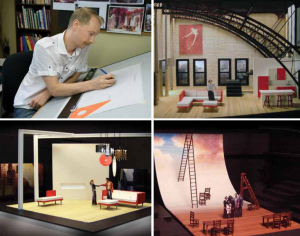by Orla Swift
Colorful shadowboxes line the shelves in Jayme Mellema’s office adjoining the lobby of the Titmus Theatre in Thompson Hall. The small-scale scenic designs– part collage art, part architectural precision– were part of his creative process in making dozens of scenic designs over the years.
But Mellema’s next theatrical venture is too big to be contained in a microcosmic shadowbox. Alice in Wonderland, opening November 14, 2012 is a fanciful journey that explores – among other themes – risk-taking, self-control, maturity, boundaries and the power of imagination.
Mellema himself will confront those same themes in his own creative process, having taken on the monumental challenge of not only designing scenery for Alice but also adapting the beloved 1865 Lewis Carroll novel into a multimedia script and directing it.
The play will feature more than a dozen actors, some in multiple roles, as well as a cast of puppets. And it will use University Theatre’s state-of-the-art projection technology at a more ambitious level than ever before.
“We’re a technological school, that’s part of what we’re about,” Mellema says. “And over the years we’ve managed to accumulate some really great things for our theatre. I want to push them. Let’s use it and push it to the max, like ‘How far can we go?’ ”
Alice is quite an undertaking for the 36-year-old artist, who has designed, directed and adapted plays before – but never tackled all at once. But Mellema has honed his artistry by delving into untested waters, and his creative approach has taken University Theatre to a new level.
“Jayme has made a tremendous difference in the way the design staff at University Theatre looks at the entire visual impact of each show,” says University Theatre director John McIlwee, whose productions with Mellema include Rent, Amadeus and Into the Woods. “His aesthetic sensibility is imaginative and acutely tuned to what is most effective for the directors’ interpretation.”
Mellema’s theatrical journey began as a detour. An aspiring visual artist, he happened into theatre in high school in Lynden, Washington, doing sound and other offstage tasks as a way to help his friends. He continued exploring theatre at Calvin College in Grand Rapids, Michigan, where his first design class convinced him to change his major from art to communications with an emphasis in theatre, keeping art as a minor. He then earned a master of fine arts in scenic design from UNC School of the Arts.
The change from visual art to theatre art isn’t so dramatic for Mellema. He sees scenic design as a form of installation art, something to be experienced rather than simply viewed. And his scenery reflects that approach, playing with shape, color and layers in ways that suggest rather than define.
“He considers perspective, color and lighting in a distinctive and non-traditional way,” says director Rachel Klem, who worked with Mellema on University Theatre’s Macbeth and Fallen Angels.
That approach might have faced resistance a century ago, but Mellema says technology has changed audiences’ expectations.
“It used to be that theatre in general was about re-creation of reality,” he says. “But now we don’t need that. We have that every day on our television, right? … So, by nature, theatre has had to evolve out of that and I think it has become a much more expressive medium now.”
Today’s scenic designs are not without their mandates – a door here, a table there. But outside of that, Mellema says, it’s all about reading between the lines of a script to get at the heart of what’s happening.
“I’m designing from the perspective of, ‘How can this space and this location express what’s going on thematically with the story? What are the characters feeling? Is this their space or is the space interacting with them? Is it confirming what they’re feeling or is it fighting with what they’re feeling?’ ”
Mellema’s designs so impressed Jack Zerbe, a theatre instructor and director at Greensboro’s Guilford College, that he tried for years to work with Mellema before finally hiring him for Sondheim’s Company in 2011.
“The artistic process with Jayme is equal parts precise analysis and joyful exploration using a wide-ranging imagination,” says Zerbe, who was first sold on Mellema after seeing his designs for Children’s Theatre of Charlotte, one of a range of theatres on a resume that also includes Duke University, North Carolina Black Repertory Company, A.J. Fletcher Opera Institute, Summer Performance Festival at Festival Park in Manteo, North Shore Music Theatre in Massachusetts, and the Princeton Festival in New Jersey, in addition to his full-time work as scenic designer for University Theatre since 2009.
“He takes great care to investigate and respect the original text on which a production is based but never lets his vision be fettered by the traditional assumptions of previous productions,” Zerbe says. “The result is a fresh approach that uses color and shape with extraordinary skill, helping audiences reconnect in deep ways with a story’s power.”
Mellema has been working on Alice for more than a year, massaging the episodic story into a cohesive script and brainstorming how best to tackle its dramatic shifts of environment and proportion.
“It sounds like this giant monster, and I guess maybe it is,” he says. “But I think it’s going to be really cool. And hopefully it will get people to look at theatre in a different way.”
To see more photos of Jayme Mellema’s designs, go to jaymemellema.com.
Orla Swift was a theatre critic and arts reporter at the News & Observer and other newspapers for 20 years, and is now director of marketing and communications at Sarah P. Duke Gardens.